A Method of Laser Frequency Stabilization Based on the Effect of Linear Dichroism in Alkali Metal Vapors in a Modulated Transverse Magnetic Field
Abstract
1. Introduction
1.1. The DAVLL Method
1.2. TL-DAVLL Method
2. Materials and Methods
2.1. General Description
2.2. Basic Principles
2.3. Experimental Setup
3. Results
3.1. The Linear Dichroism Signal in the Cs Cell
d2f/dT2 = –0.61 ± 0.29 MHz/°C2.
3.2. Experiment Demonstrating Laser Frequency Stabilization
4. Discussion
- The method is extremely simple: the setup for the error signal detection consists of a magnetic shield, a 2D or 3D Helmholtz coil, a cell, a heater, and a photodetector;
- The method does not require any type of modulation of the laser beam;
- The modulation of the magnetic field allows the dichroism signal at a non-zero frequency to be registered;
- The method does not require strong magnetic fields; it is realized in transverse fields in the μT range;
- The resilience of the parameters to residual longitudinal fields at the level of tenths of μT allows the use of minimal shielding, like a single-layer shield or even a system of compensating coils;
- The registration of the dichroism signal is possible on the second harmonic of the modulation frequency, which even in the most compact version of the scheme allows for avoiding the influence of the magnetic field generated by the coil system on the photodetector, cables, and elements of electrical circuits;
- The laser stabilization frequency in this method is determined by the collisional shift of transition frequencies in the used cell; therefore, the choice of the locking frequency can be made not only by introducing the locking level’s artificial offset but also by selecting the gas filling of the cell.
- 8.
- The stabilization of the laser using the zero point of the dichroism signal is possible at the frequency corresponding approximately to the top of the absorption profile in the gas cell;
- 9.
- A high achievable signal-to-noise ratio (~106 with respect to the shot noise) makes it possible to realize a frequency resolution at the level of kilohertz or tens of kilohertz in a one-hertz bandwidth;
- 10.
- The presence of a smooth extremum of the dependence of the locking frequency on the cell temperature and light intensity makes it possible to achieve a high (at the level of hundreds or even tens of kilohertz) stability of the locking frequency;
- 11.
- The width of the linear part of the dependence of the dichroism signal on the frequency tuning allows (with a corresponding loss of accuracy of up to ~10 MHz) a controlled tuning of the laser light frequency within the profile of the absorption line (depending on the cell gas filling, from hundreds of MHz to units of GHz);
- 12.
- The magnetic field modulation frequency can reach ten kilohertz.
5. Conclusions
Author Contributions
Funding
Data Availability Statement
Acknowledgments
Conflicts of Interest
References
- Mitra, D.; Leung, K.H.; Zelevinsky, T. Quantum Control of Molecules for Fundamental Physics. Phys. Rev. A 2022, 105, 040101. [Google Scholar] [CrossRef]
- Tino, G.M. Testing Gravity with Cold Atom Interferometry: Results and Prospects. Quantum Sci. Technol. 2021, 6, 024014. [Google Scholar] [CrossRef]
- Gisin, N.; Thew, R. Quantum Communication. Nat. Photonics 2007, 1, 165–171. [Google Scholar] [CrossRef]
- Paraïso, T.K.; Woodward, R.I.; Marangon, D.G.; Lovic, V.; Yuan, Z.; Shields, A.J. Advanced Laser Technology for Quantum Communications (Tutorial Review). Adv. Quantum Technol. 2021, 4, 2100062. [Google Scholar] [CrossRef]
- Ludlow, A.D.; Boyd, M.M.; Ye, J.; Peik, E.; Schmidt, P.O. Optical Atomic Clocks. Rev. Mod. Phys. 2015, 87, 637–701. [Google Scholar] [CrossRef]
- Lu, Y.; Zhao, T.; Zhu, W.; Liu, L.; Zhuang, X.; Fang, G.; Zhang, X. Recent Progress of Atomic Magnetometers for Geomagnetic Applications. Sensors 2023, 23, 5318. [Google Scholar] [CrossRef] [PubMed]
- Zhou, P.; Quan, W.; Wei, K.; Liang, Z.; Hu, J.; Liu, L.; Hu, G.; Wang, A.; Ye, M. Application of VCSEL in Bio-Sensing Atomic Magnetometers. Biosensors 2022, 12, 1098. [Google Scholar] [CrossRef]
- Li, J.; Quan, W.; Zhou, B.; Wang, Z.; Lu, J.; Hu, Z.; Liu, G.; Fang, J. SERF Atomic Magnetometer–Recent Advances and Applications: A Review. IEEE Sens. J. 2018, 18, 8198–8207. [Google Scholar] [CrossRef]
- Petrenko, M.V.; Dmitriev, S.P.; Pazgalev, A.S.; Ossadtchi, A.E.; Vershovskii, A.K. Towards the Non-Zero Field Cesium Magnetic Sensor Array for Magnetoencephalography. IEEE Sens. J. 2021, 21, 18626–18632. [Google Scholar] [CrossRef]
- Budker, D.; Romalis, M. Optical Magnetometry. Nat. Physics 2007, 3, 227. [Google Scholar] [CrossRef]
- Peng, J.; Jia, S.; Bian, J.; Zhang, S.; Liu, J.; Zhou, X. Recent Progress on Electromagnetic Field Measurement Based on Optical Sensors. Sensors 2019, 19, 2860. [Google Scholar] [CrossRef] [PubMed]
- Garrido Alzar, C.L. Compact Chip-Scale Guided Cold Atom Gyrometers for Inertial Navigation: Enabling Technologies and Design Study. AVS Quantum Sci. 2019, 1, 014702. [Google Scholar] [CrossRef]
- Liu, G.-Q.; Liu, R.-B.; Li, Q. Nanothermometry with Enhanced Sensitivity and Enlarged Working Range Using Diamond Sensors. Acc. Chem. Res. 2023, 56, 95–105. [Google Scholar] [CrossRef] [PubMed]
- Barry, J.F.; Schloss, J.M.; Bauch, E.; Turner, M.J.; Hart, C.A.; Pham, L.M.; Walsworth, R.L. Sensitivity Optimization for NV-Diamond Magnetometry. Rev. Mod. Phys. 2020, 92, 015004. [Google Scholar] [CrossRef]
- Fescenko, I.; Jarmola, A.; Savukov, I.; Kehayias, P.; Smits, J.; Damron, J.; Ristoff, N.; Mosavian, N.; Acosta, V.M. Diamond Magnetometer Enhanced by Ferrite Flux Concentrators. Phys. Rev. Res. 2020, 2, 023394. [Google Scholar] [CrossRef] [PubMed]
- Wickenbrock, A.; Zheng, H.; Bougas, L.; Leefer, N.; Afach, S.; Jarmola, A.; Acosta, V.M.; Budker, D. Microwave-Free Magnetometry with Nitrogen-Vacancy Centers in Diamond. Appl. Phys. Lett. 2016, 109, 053505. [Google Scholar] [CrossRef]
- Bothwell, T.; Kennedy, C.J.; Aeppli, A.; Kedar, D.; Robinson, J.M.; Oelker, E.; Staron, A.; Ye, J. Resolving the Gravitational Redshift across a Millimetre-Scale Atomic Sample. Nature 2022, 602, 420–424. [Google Scholar] [CrossRef] [PubMed]
- Huntemann, N.; Sanner, C.; Lipphardt, B.; Tamm, C.; Peik, E. Single-Ion Atomic Clock with 3 × 10−18 Systematic Uncertainty. Phys. Rev. Lett. 2016, 116, 063001. [Google Scholar] [CrossRef]
- Wu, Y.; Sun, B.; Li, X. Semiconductor Laser Active Frequency Stabilization Technologies: A Review. J. Korean Phys. Soc. 2021, 79, 795–809. [Google Scholar] [CrossRef]
- Yan, Y.; Liu, G.; Lin, H.; Yin, K.; Wang, K.; Lu, J. VCSEL Frequency Stabilization for Optically Pumped Magnetometers. Chin. Opt. Lett. 2021, 19, 121407. [Google Scholar] [CrossRef]
- Wieman, C.; Hänsch, T.W. Doppler-Free Laser Polarization Spectroscopy. Phys. Rev. Lett. 1976, 36, 1170–1173. [Google Scholar] [CrossRef]
- Yoshikawa, Y.; Umeki, T.; Mukae, T.; Torii, Y.; Kuga, T. Frequency Stabilization of a Laser Diode with Use of Light-Induced Birefringence in an Atomic Vapor. Appl. Opt. AO 2003, 42, 6645–6649. [Google Scholar] [CrossRef] [PubMed]
- Kerckhoff, J.A.; Bruzewicz, C.D.; Uhl, R.; Majumder, P.K. A Frequency Stabilization Method for Diode Lasers Utilizing Low-Field Faraday Polarimetry. Rev. Sci. Instrum. 2005, 76, 093108. [Google Scholar] [CrossRef]
- Chéron, B.; Gilles, H.; Hamel, J.; Moreau, O.; Sorel, H. Laser Frequency Stabilization Using Zeeman Effect. J. Phys. III France 1994, 4, 401–406. [Google Scholar] [CrossRef]
- Corwin, K.L.; Lu, Z.-T.; Hand, C.F.; Epstein, R.J.; Wieman, C.E. Frequency-Stabilized Diode Laser with the Zeeman Shift in an Atomic Vapor. Appl. Opt. AO 1998, 37, 3295–3298. [Google Scholar] [CrossRef]
- Yashchuk, V.V.; Budker, D.; Davis, J.R. Laser Frequency Stabilization Using Linear Magneto-Optics. Rev. Sci. Instrum. 2000, 71, 341–346. [Google Scholar] [CrossRef]
- Reeves, J.M.; Garcia, O.; Sackett, C.A. Temperature Stability of a Dichroic Atomic Vapor Laser Lock. Appl. Opt. AO 2006, 45, 372–376. [Google Scholar] [CrossRef] [PubMed]
- Wasik, G.; Gawlik, W.; Zachorowski, J.; Zawadzki, W. Laser Frequency Stabilization by Doppler-Free Magnetic Dichroism. Appl. Phys. B 2002, 75, 613–619. [Google Scholar] [CrossRef]
- Harris, M.L.; Cornish, S.L.; Tripathi, A.; Hughes, I.G. Optimization of Sub-Doppler DAVLL on the Rubidium D2 Line. J. Phys. B At. Mol. Opt. Phys. 2008, 41, 085401. [Google Scholar] [CrossRef]
- Zhang, L.-J.; Zhang, H.; Zhao, Y.-T.; Xiao, L.-T.; Jia, S.-T. Non-Crossover Sub-Doppler DAVLL in Selective Reflection Scheme. Chin. Phys. B 2019, 28, 084211. [Google Scholar] [CrossRef]
- Talker, E.; Arora, P.; Zektzer, R.; Sebbag, Y.; Dikopltsev, M.; Levy, U. Light-Induced Atomic Desorption in Microfabricated Vapor Cells for Demonstrating Quantum Optical Applications. Phys. Rev. Appl. 2021, 15, L051001. [Google Scholar] [CrossRef]
- Lee, C.; Iwata, G.Z.; Corsini, E.; Higbie, J.M.; Knappe, S.; Ledbetter, M.P.; Budker, D. Small-Sized Dichroic Atomic Vapor Laser Lock. Rev. Sci. Instrum. 2011, 82, 043107. [Google Scholar] [CrossRef] [PubMed]
- Tiwari, V.B.; Singh, S.; Mishra, S.R.; Rawat, H.S.; Mehendale, S.C. Laser Frequency Stabilization Using Doppler-Free Bi-Polarization Spectroscopy. Opt. Commun. 2006, 263, 249–255. [Google Scholar] [CrossRef]
- Singh, V.; Tiwari, V.B.; Mishra, S.R.; Rawat, H.S. A Tunable Doppler-Free Dichroic Lock for Laser Frequency Stabilization. Appl. Phys. B 2016, 122, 225. [Google Scholar] [CrossRef]
- Marchant, A.L.; Händel, S.; Wiles, T.P.; Hopkins, S.A.; Adams, C.S.; Cornish, S.L. Off-Resonance Laser Frequency Stabilization Using the Faraday Effect. Opt. Lett. OL 2011, 36, 64–66. [Google Scholar] [CrossRef] [PubMed]
- Scholtes, T.; Schultze, V.; IJsselsteijn, R.; Woetzel, S.; Meyer, H.-G. Light-Narrowed Optically Pumped ${M}_{x}$ Magnetometer with a Miniaturized Cs Cell. Phys. Rev. A 2011, 84, 043416. [Google Scholar] [CrossRef]
- Pustelny, S.; Schultze, V.; Scholtes, T.; Budker, D. Dichroic Atomic Vapor Laser Lock with Multi-Gigahertz Stabilization Range. Rev. Sci. Instrum. 2016, 87, 063107. [Google Scholar] [CrossRef]
- Hasegawa, T.; Deguchi, M. Laser Frequency Locking by Dispersive Response of Atoms in Transversal Magnetic Field. J. Opt. Soc. Am. B JOSAB 2009, 26, 1216–1220. [Google Scholar] [CrossRef]
- Okubo, S.; Iwakuni, K.; Hasegawa, T. Modulation-Free Laser Frequency Stabilization to a Saturated Sub-Doppler Spectral Line in a Transversal Magnetic Field. Opt. Commun. 2012, 285, 4107–4111. [Google Scholar] [CrossRef]
- Chen, X.; Telegdi, V.L.; Weis, A. Quantitative Observation of the Nonlinear Dichroic Voigt Effect near the Cs D2-Line. Opt. Commun. 1990, 78, 337–340. [Google Scholar] [CrossRef]
- Omont, A. Irreducible Components of the Density Matrix. Application to Optical Pumping. Prog. Quantum Electron. 1977, 5, 69–138. [Google Scholar] [CrossRef]
- Happer, W. Optical Pumping. Rev. Mod. Phys. 1972, 44, 169–249. [Google Scholar] [CrossRef]
- Petrenko, M.V.; Pazgalev, A.S.; Vershovskii, A.K. Single-Beam All-Optical Non-Zero Field Magnetometric Sensor for Magnetoencephalography Applications. Phys. Rev. Appl. 2021, 15, 064072. [Google Scholar] [CrossRef]
- Petrenko, M.V.; Pazgalev, A.S.; Vershovskii, A.K. Ultimate Parameters of an All-Optical MX Resonance in Cs in Ultra-Weak Magnetic Field. arXiv 2023, arXiv:2306.16924. [Google Scholar]
- Meade, M. Advances in Lock-in Amplifiers. J. Phys. E Sci. Instrum. 1982, 15, 395. [Google Scholar] [CrossRef]
- Kishore, K.; Akbar, S. Evolution of Lock-in Amplifier as Portable Sensor Interface Platform: A Review. IEEE Sens. J. 2020, 20, 10345–10354. [Google Scholar] [CrossRef]
- Pitz, G.A.; Sandoval, A.J.; Tafoya, T.B.; Klennert, W.L.; Hostutler, D.A. Pressure Broadening and Shift of the Rubidium D1 Transition and Potassium D2 Transitions by Various Gases with Comparison to Other Alkali Rates. J. Quant. Spectrosc. Radiat. Transf. 2014, 140, 18–29. [Google Scholar] [CrossRef]
- Oreto, P.; Jau, Y.-Y.; Post, A.; Kuzma, N.; Happer, W. Buffer-Gas-Induced Shift and Broadening of Hyperfine Resonances in Alkali-Metal Vapors. Phys. Rev. A—At. Mol. Opt. Phys. 2004, 69, 042716. [Google Scholar] [CrossRef]
- Bandi, T.N. A Comprehensive Overview of Atomic Clocks and Their Applications. Demo J. 2024, 1, 40–50. [Google Scholar] [CrossRef]
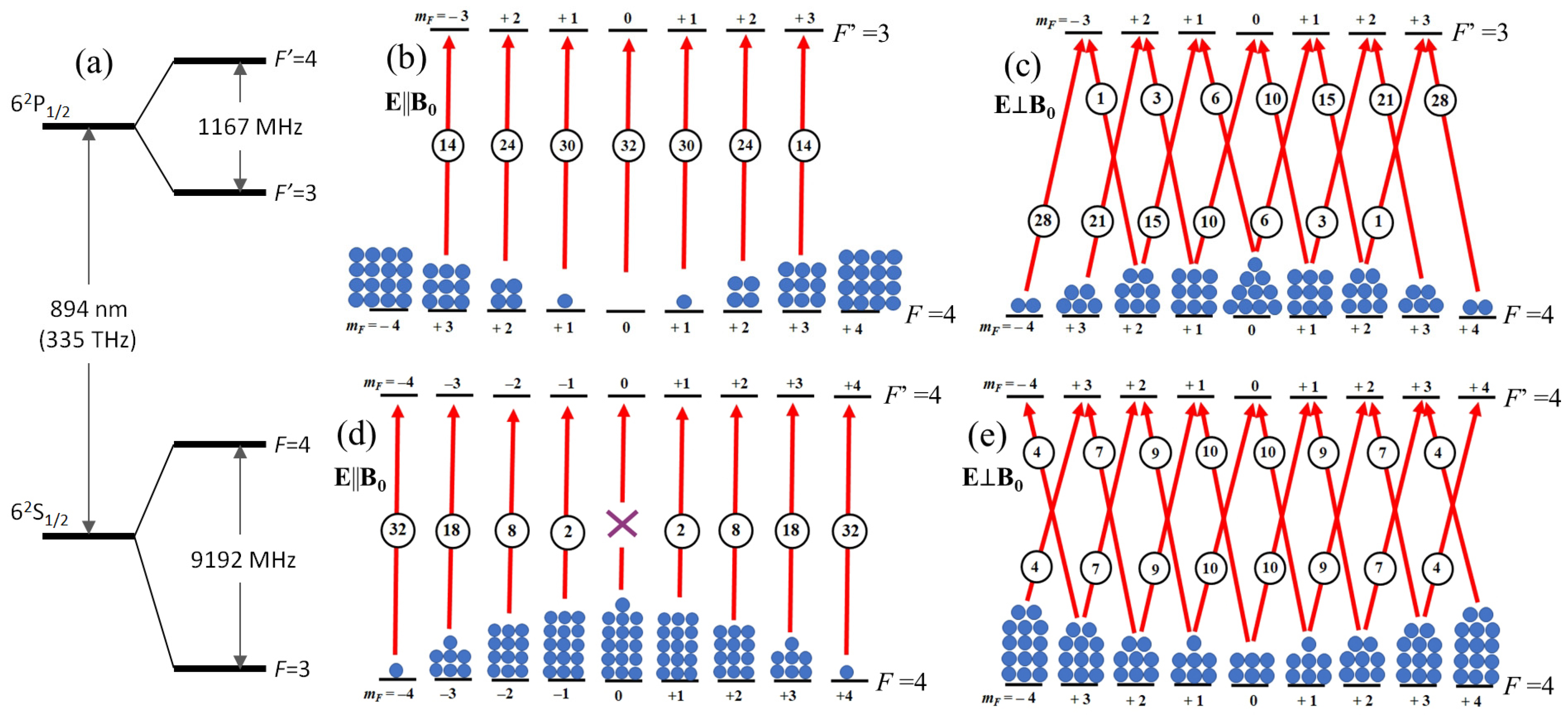
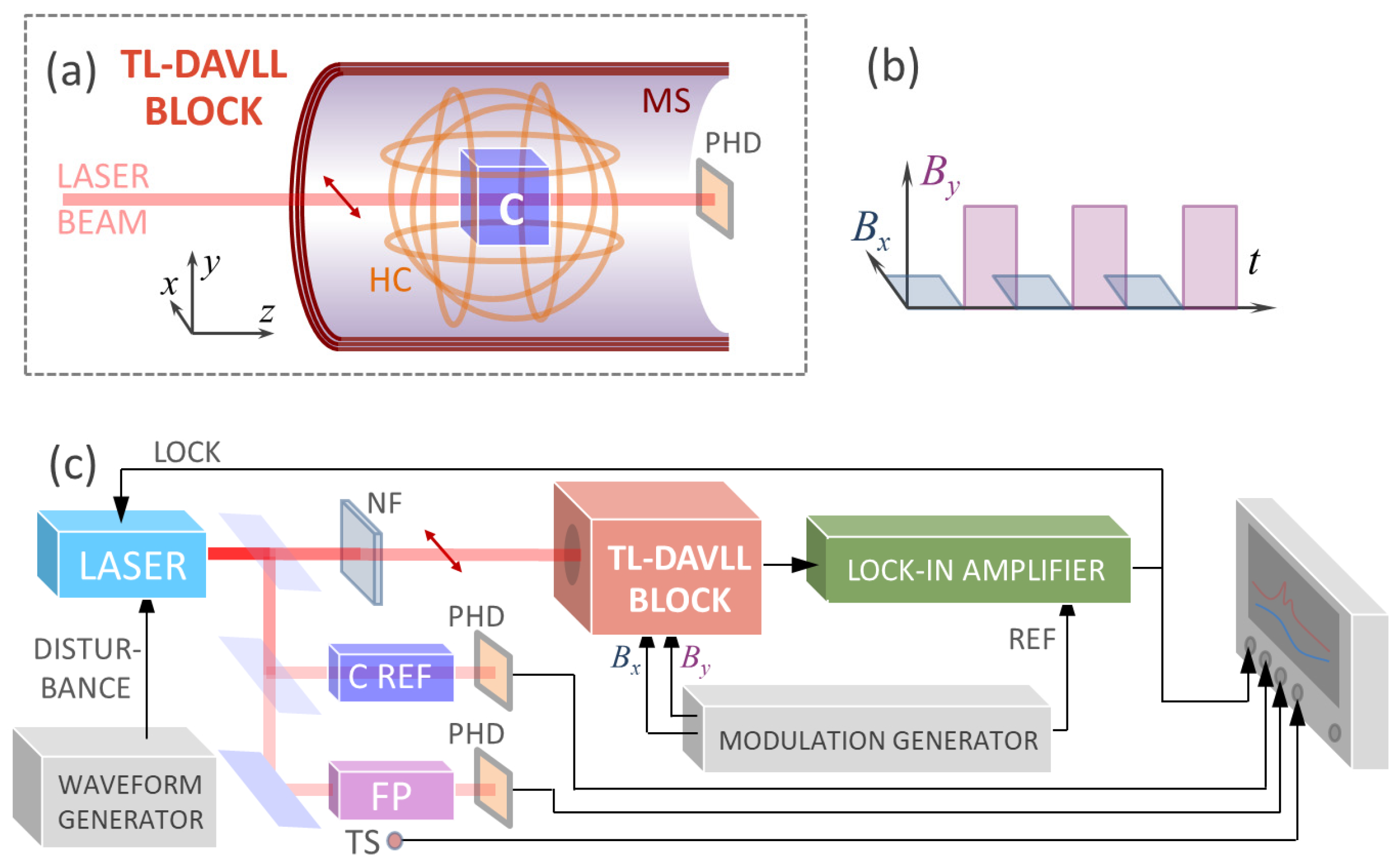
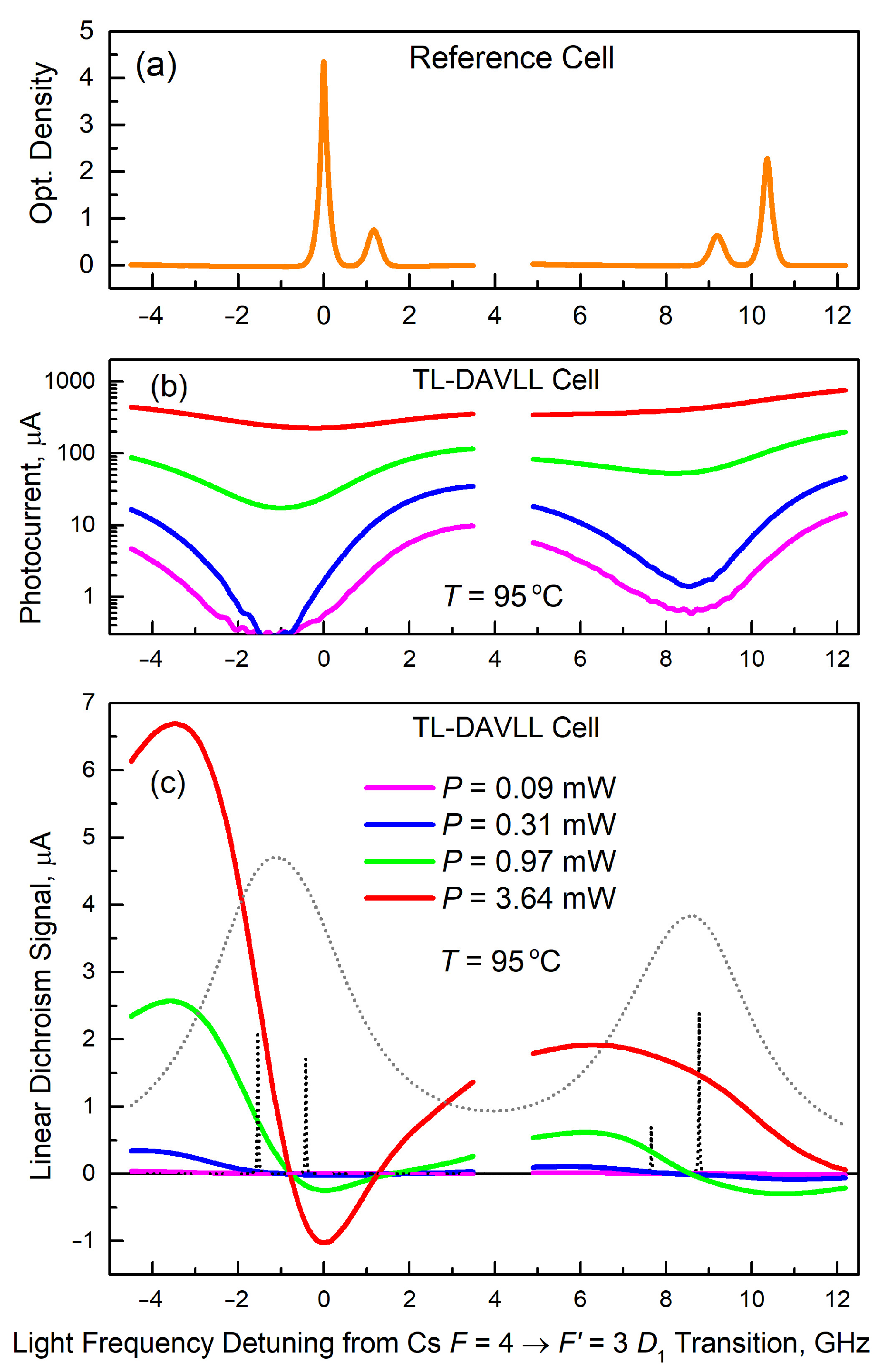


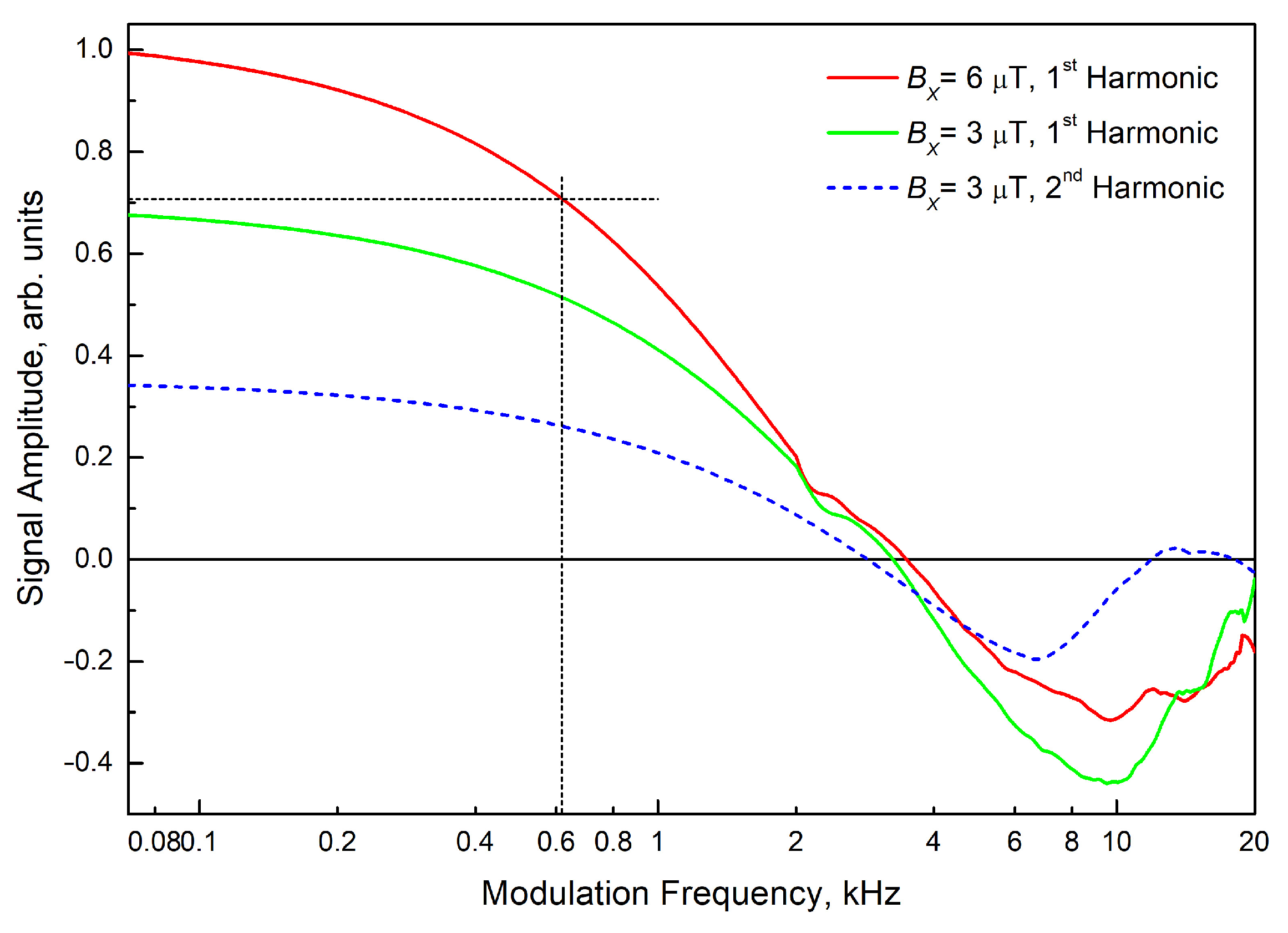
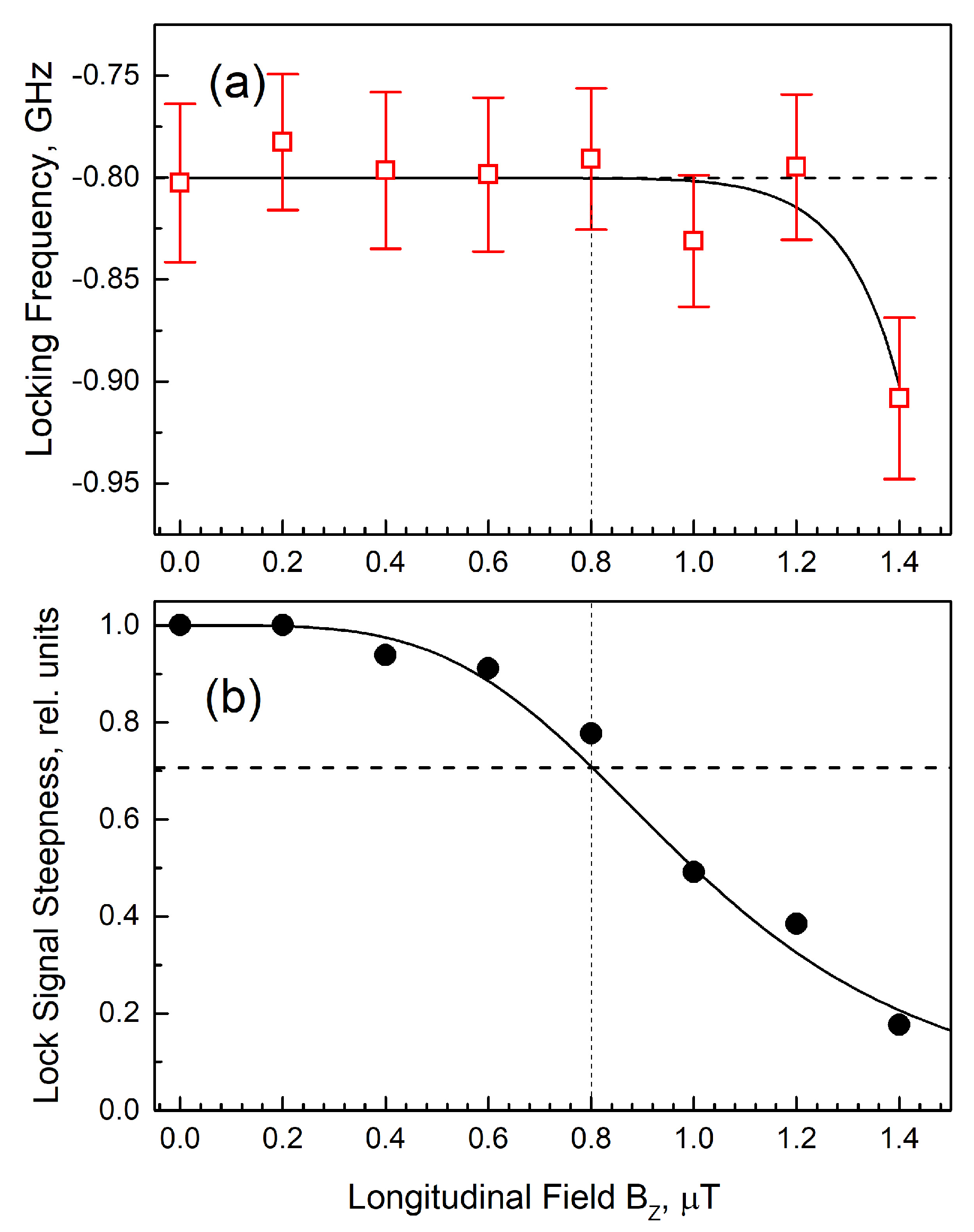
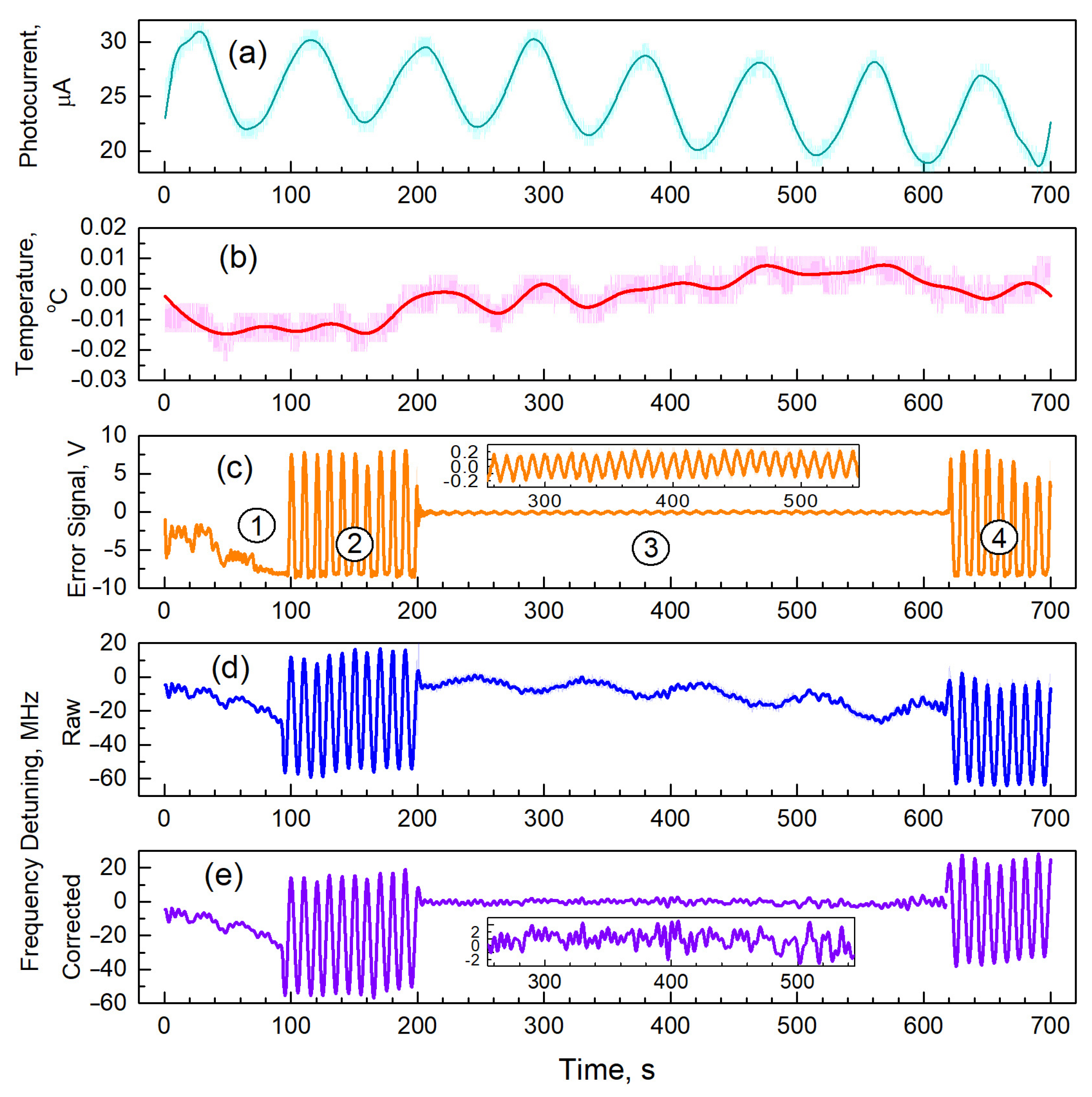
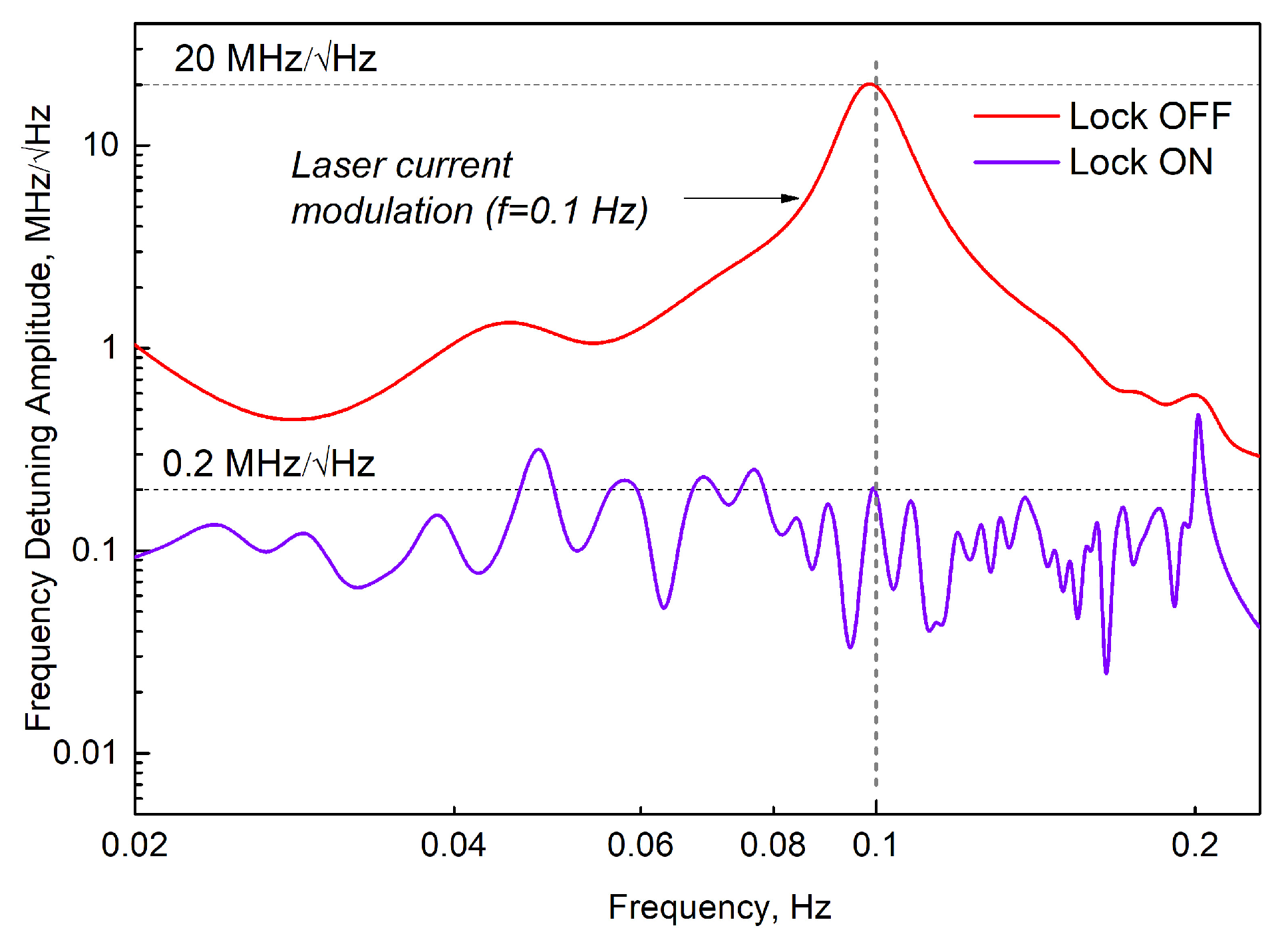
Disclaimer/Publisher’s Note: The statements, opinions and data contained in all publications are solely those of the individual author(s) and contributor(s) and not of MDPI and/or the editor(s). MDPI and/or the editor(s) disclaim responsibility for any injury to people or property resulting from any ideas, methods, instructions or products referred to in the content. |
© 2024 by the authors. Licensee MDPI, Basel, Switzerland. This article is an open access article distributed under the terms and conditions of the Creative Commons Attribution (CC BY) license (https://creativecommons.org/licenses/by/4.0/).
Share and Cite
Petrenko, M.V.; Pazgalev, A.S.; Vershovskii, A.K. A Method of Laser Frequency Stabilization Based on the Effect of Linear Dichroism in Alkali Metal Vapors in a Modulated Transverse Magnetic Field. Photonics 2024, 11, 926. https://doi.org/10.3390/photonics11100926
Petrenko MV, Pazgalev AS, Vershovskii AK. A Method of Laser Frequency Stabilization Based on the Effect of Linear Dichroism in Alkali Metal Vapors in a Modulated Transverse Magnetic Field. Photonics. 2024; 11(10):926. https://doi.org/10.3390/photonics11100926
Chicago/Turabian StylePetrenko, Mikhail V., Anatoly S. Pazgalev, and Anton K. Vershovskii. 2024. "A Method of Laser Frequency Stabilization Based on the Effect of Linear Dichroism in Alkali Metal Vapors in a Modulated Transverse Magnetic Field" Photonics 11, no. 10: 926. https://doi.org/10.3390/photonics11100926
APA StylePetrenko, M. V., Pazgalev, A. S., & Vershovskii, A. K. (2024). A Method of Laser Frequency Stabilization Based on the Effect of Linear Dichroism in Alkali Metal Vapors in a Modulated Transverse Magnetic Field. Photonics, 11(10), 926. https://doi.org/10.3390/photonics11100926





